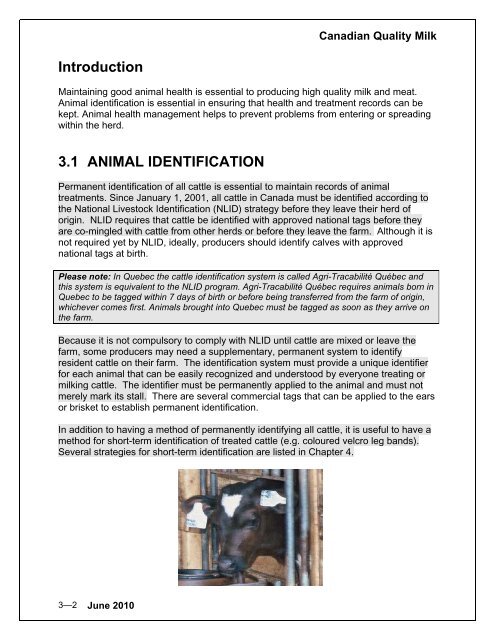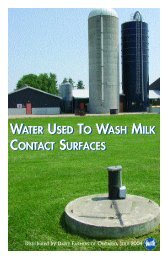Canadian Quality Milk On-Farm Food Safety Program - Centre ...
Canadian Quality Milk On-Farm Food Safety Program - Centre ...
Canadian Quality Milk On-Farm Food Safety Program - Centre ...
Create successful ePaper yourself
Turn your PDF publications into a flip-book with our unique Google optimized e-Paper software.
<strong>Canadian</strong> <strong>Quality</strong> <strong>Milk</strong><br />
Introduction<br />
Maintaining good animal health is essential to producing high quality milk and meat.<br />
Animal identification is essential in ensuring that health and treatment records can be<br />
kept. Animal health management helps to prevent problems from entering or spreading<br />
within the herd.<br />
3.1 ANIMAL IDENTIFICATION<br />
Permanent identification of all cattle is essential to maintain records of animal<br />
treatments. Since January 1, 2001, all cattle in Canada must be identified according to<br />
the National Livestock Identification (NLID) strategy before they leave their herd of<br />
origin. NLID requires that cattle be identified with approved national tags before they<br />
are co-mingled with cattle from other herds or before they leave the farm. Although it is<br />
not required yet by NLID, ideally, producers should identify calves with approved<br />
national tags at birth.<br />
Please note: In Quebec the cattle identification system is called Agri-Tracabilité Québec and<br />
this system is equivalent to the NLID program. Agri-Tracabilité Québec requires animals born in<br />
Quebec to be tagged within 7 days of birth or before being transferred from the farm of origin,<br />
whichever comes first. Animals brought into Quebec must be tagged as soon as they arrive on<br />
the farm.<br />
Because it is not compulsory to comply with NLID until cattle are mixed or leave the<br />
farm, some producers may need a supplementary, permanent system to identify<br />
resident cattle on their farm. The identification system must provide a unique identifier<br />
for each animal that can be easily recognized and understood by everyone treating or<br />
milking cattle. The identifier must be permanently applied to the animal and must not<br />
merely mark its stall. There are several commercial tags that can be applied to the ears<br />
or brisket to establish permanent identification.<br />
In addition to having a method of permanently identifying all cattle, it is useful to have a<br />
method for short-term identification of treated cattle (e.g. coloured velcro leg bands).<br />
Several strategies for short-term identification are listed in Chapter 4.<br />
3—2<br />
June 2010
















